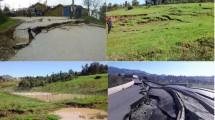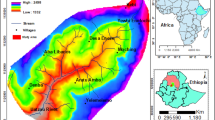Abstract
Slope instability phenomena in Souk Ahras region are annually causing a great amount of damage mainly to road infrastructure, water main supply, and buildings. The main problem is that instabilities keep reoccurring despite the remedial measures brought about every time. The fact is there is not only a single factor that is behind these instabilities rather than the interplay of a large variety of factors pertaining to the geological, geomorphological, and hydrological characteristics of the terrain as well as human-related activities. Consequently, a spatial database of ten landslide-related factors were identified and used to assess landslide susceptibility and establish a model capable of predicting landslide prone areas. For this reason, three statistical methods are used for the landslide susceptibility assessment: logistic regression, frequency ratio, and weights of evidence in a GIS platform. A landslide inventory map was established from visual interpretation of satellite images and field survey data. Three landslide susceptibility maps were produced using different statistical models. Each susceptibility map subdivides the study area into five classes of landslide susceptibility: very low, low, moderate, high, and very high. These raster-based susceptibility maps were compared and verified with both training and validating inventory data. The area under the curve values, based on success rate, are between 82.11 and 90.57%, and those based on prediction rate are between 83.14 and 90.91%. The results showed that the logistic regression method is more consistent and reliable than the two other techniques, and it has the best performance among the three statistical methods.


















Similar content being viewed by others
References
Aditian A, Kubota T, Shinohara Y (2018) Comparison of GIS-based landslide susceptibility models using frequency ratio, logistic regression, and artificial neural network in a tertiary region of Ambon, Indonesia. Geomorphology 318:101–111 ISO 690
Avtar R, Singh CK, Singh G, Verma RL, Mukherjee S, Sawada H (2011) Landslide susceptibility zonation study using remote sensing and GIS technology in the Ken-Betwa River Link area, India. Bull Eng Geol Environ 70(4):595–606
Bai SB, Wang J, Lü GN, Zhou PG, Hou SS, Xu SN (2010) GIS-based logistic regression for landslide susceptibility mapping of the Zhongxian segment in the Three Gorges Area, China. Geomorphology 115(1):23–31
Bell FG (1999) Geological hazards: their assessment, avoidance and mitigation, 1st edn. E and FN SPON, London and New York
Bonham-Carter GF (1994) Geographic information systems for geoscientists-modeling with GIS. Computer methods in the geoscientists. Elsevier, Burlington, p 13 398p
Bonham-Carter GF, Agterberg FP, Wright DF (1989) Weights of evidence modelling: a new approach to mapping mineral potential. In: Agterberg FP, Bonham-Carter GF (eds) Statistical applications in earth sciences. Geological Survey of Canada, Ottawa, pp 171–183
Brabb EE (1984) Innovative approaches to landslide hazard and risk mapping, Proc of the 4th Int Symp on Landslides, 16–21 September, Toronto, Ontario, Canada. Canadian Geotechnical Society, Toronto, vol. 1, pp 307–324
Bui DT, Pradhan B, Lofman O, Revhaug I, Dick OB (2012) Spatial prediction of landslide hazards in HoaBinh province (Vietnam): a comparative assessment of the efficacy of evidential belief functions and fuzzy logic models. Catena 96:28–40
Carrara A, Cardinali M, Detti R, Guzzetti F, Pasqui V and Reichenbach P (1990) Geographical information system and multivariate models in landslide hazard evaluation. In: Proceeding 6th International Conference and Field Workshop on Landslides, Switzerland-Austria-Italy, 1, pp 17–28
Carrara A, Cardinali M, Detti R, Guzzetti F, Pasqui V, Reichenbach P (1991) GIS techniques and statistical models in evaluating landslide hazard. Earth Surf Process Landf 16:427–445
Chabbi A, Chouabbi A, Chermiti A, Ben Youssef M, Kouadria T & Ghanmi M (2016) La mise en évidence d’une nappe de charriage en structure imbriquee: cas de la nappe tellienne d’Ouled Driss, Souk Ahras, Algerie. Courrier du Savoir—N°21, pp 149–156. Revue de l'université Mohamed Khider – Biskra, Algérie.
Chen JW, Chue YS, Chen YR (2013) The application of the genetic adaptive neural network in landslide disaster assessment. J Mar Sci Technol 21(4):442–452
Chen W, Wang J, Xie X, Hong H, Van Trung N, Bui DT, Li X (2016) Spatial prediction of landslide susceptibility using integrated frequency ratio with entropy and support vector machines by different kernel functions. Environ Earth Sci 75(20):1344
Dahal RK, Hasegawa S, Nonomura A, Yamanaka M, Masuda T, Nishino K (2008) GIS-based weights-of-evidence modelling of rainfall-induced landslides in small catchments for landslide susceptibility mapping. Environ Geol 54(2):311–324
García-Rodríguez MJ, Malpica JA (2010) Assessment of earthquake-triggered landslide susceptibility in El Salvador based on an Artificial Neural Network model. Nat Hazards Earth Syst Sci 10(6):1307–1315
Hadji R, Limani Y, Boumazbeur A, Demdoum A, Zighmi K, Zahri F, Chouabi A (2014) Climate change and their influence on shrinkage-swelling clays susceptibility in a semi-arid zone: a case study of Souk Ahras municipality, NE-Algeria. Desalin Water Treat 52(10–12):2057–2072
Hosmer DW & Lemeshow S (2000) Interpretation of the fitted logistic regression model. Applied Logistic Regression,Wiley Series in Probability and Statistics, 2nd ed, pp 47–90
Jacobs L, Dewitte O, Poesen J, Sekajugo J, Nobile A, Rossi M, Kervyn M (2018) Field-based landslide susceptibility assessment in a data-scarce environment: the populated areas of the Rwenzori Mountains. Nat Hazards Earth Syst Sci 18(1):105–124
Kayastha P, Dhital MR, De Smedt F (2012) Landslide susceptibility mapping using the weight of evidence method in the Tinau watershed, Nepal. Nat Hazards 63(2):479–498
Khosravi K, Nohani E, Maroufinia E, Pourghasemi HR (2016) A GIS-based flood susceptibility assessment and its mapping in Iran: a comparison between frequency ratio and weights-of-evidence bivariate statistical models with multi-criteria decision-making technique. Nat Hazards 83(2):947–987
Le L, Lin Q, Wang Y (2017) Landslide susceptibility mapping on a global scale using the method of logistic regression. Nat Hazards Earth Syst Sci 17(8):1411
Lee S (2005) Application of logistic regression model and its validation for landslide susceptibility mapping using GIS and remote sensing data. Int J Remote Sens 26(7):1477–1491
Lee S, Evangelista DG (2006) Earthquake-induced landslide-susceptibility mapping using an artificial neural network. Nat Hazards Earth Syst Sci 6(5):687–695
Lee S, Min K (2001) Statistical analysis of landslide susceptibility at Yongin, Korea. Environ Geol 40(9):1095–1113
Lee S, Sambath T (2006) Landslide susceptibility mapping in the Damrei Romel area, Cambodia using frequency ratio and logistic regression models. Environ Geol 50(6):847–855
Lee S, Talib JA (2005) Probabilistic landslide susceptibility and factor effect analysis. Environ Geol 47(7):982–990
Li T, Wang S (1992) Landslide hazards and their mitigation in China. SciencePress, Beijing 84 pp
Mahtali H (2009) Identification of swelling potential of a Souk Ahras Area soil. Proceeding of International Symposium of No Saturated Soil and Environment, Tlemcen, p 156
McFadden D (1973) Conditional logit analysis of qualitative choice behavior. University of California, Berkeley
Neuhäuser B, Terhorst B (2007) Landslide susceptibility assessment using “weights-of-evidence” applied to a study area at the Jurassic escarpment (SW Germany). Geomorphology 86(1):12–24
Nourani V, Pradhan B, Ghaffari H, Sharifi SS (2014) Landslide susceptibility mapping at Zonouz Plain, Iran using genetic programming and comparison with frequency ratio, logistic regression, and artificial neural network models. Nat Hazards 71(1):523–547
Pradhan B, Lee S (2010) Landslide susceptibility assessment and factor effect analysis: backpropagation artificial neural networks and their comparison with frequency ratio and bivariate logistic regression modelling. Environ Model Softw 25(6):747–759
Pradhan B, Oh HJ, Buchroithner M (2010) Weights-of-evidence model applied to landslide susceptibility mapping in a tropical hilly area. Geomat Nat Haz Risk 1(3):199–223
Regmi NR, Giardino JR, Vitek JD (2010) Modeling susceptibility to landslides using the weight of evidence approach: Western Colorado, USA. Geomorphology 115(1):172–187
Saaty TL (1980) The analytic hierarchy process: planning. Priority setting. Resource Allocation, MacGraw-Hill, New York International Book Company, p 287
Spiegelhalter, D. J., & Knill-Jones, R. P. (1984). Statistical and knowledge-based approaches to clinical decision-support systems, with an application in gastroenterology. J Royal Stat Soc Ser A (General) 35–77.
Teerarungsigul S, Torizin J, Fuchs M, Kühn F, Chonglakmani C (2016) An integrative approach for regional landslide susceptibility assessment using weight of evidence method: a case study of Yom River Basin, Phrae Province, northern Thailand. Landslides 13(5):1151–1165
Varnes DJ (1984) Landslide hazard zonation: a review of principles and practice. UNESCO, Paris ISBN 92-3-101895-7, 63p
Vila JM (1980) The north-eastern Alpine chain and Algerian-Tunisian border. PhD thesis, P. et M. Curie university, Paris VI, p 353
Wang LJ, Guo M, Sawada K, Lin J, Zhang J (2016) A comparative study of landslide susceptibility maps using logistic regression, frequency ratio, decision tree, weights of evidence and artificial neural network. Geosci J 20(1):117–136
Wilson JP, Gallant JC (eds) (2000) Terrain analysis: principles and applications. John Wiley & Sons, Hoboken
Xu C, Xu X, Dai F, Xiao J, Tan X, Yuan R (2012) Landslide hazard mapping using GIS and weight of evidence model in Qingshui river watershed of 2008 Wenchuan earthquake struck region. J Earth Sci 23(1):97–120
Yesilnacar E, Topal T (2005) Landslide susceptibility mapping: a comparison of logistic regression and neural networks methods in a medium scale study, Hendek region (Turkey). Eng Geol 79(3):251–266
Youssef AM, Al-Kathery M, Pradhan B (2015) Landslide susceptibility mapping at Al-Hasher area, Jizan (Saudi Arabia) using GIS-based frequency ratio and index of entropy models. Geosci J 19(1):113–134
Acknowledgements
The authors would like to thank Dr. Debi Prasanna Kanungo and the anonymous reviewers for their valuable comments of the manuscript. The data analysis was carried out as a part of the first author’s PhD studies at the Department of Geology, Earth Sciences, Geography and Spatial Planning Faculty, University of Constantine 1, Constantine, Algeria.
Author information
Authors and Affiliations
Corresponding author
Rights and permissions
About this article
Cite this article
Mahdadi, F., Boumezbeur, A., Hadji, R. et al. GIS-based landslide susceptibility assessment using statistical models: a case study from Souk Ahras province, N-E Algeria. Arab J Geosci 11, 476 (2018). https://doi.org/10.1007/s12517-018-3770-5
Received:
Accepted:
Published:
DOI: https://doi.org/10.1007/s12517-018-3770-5




